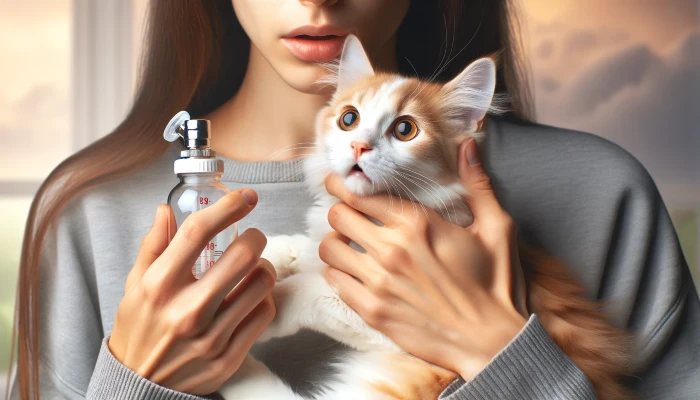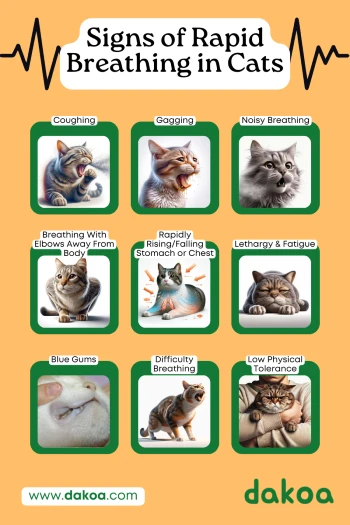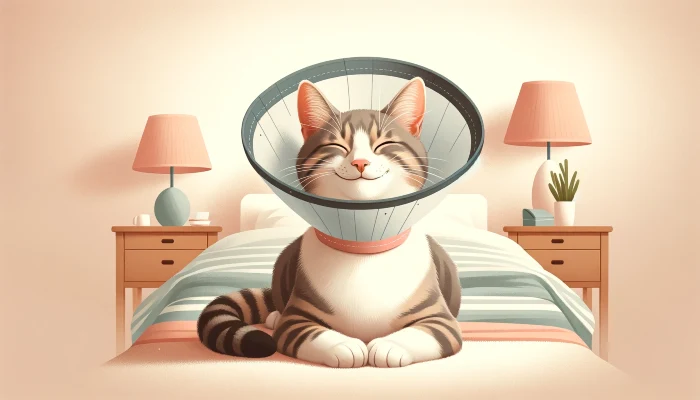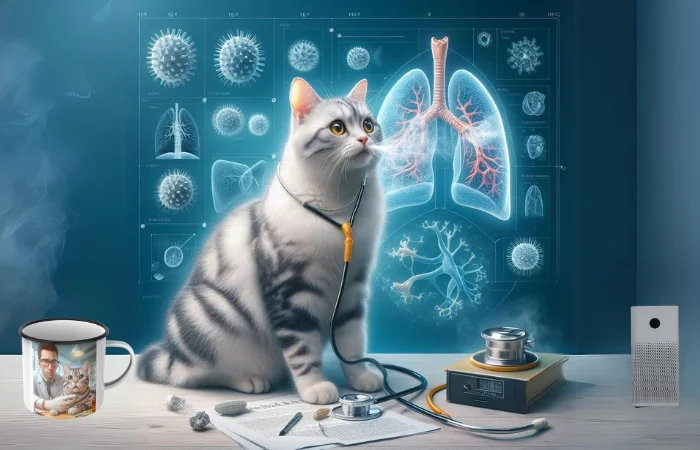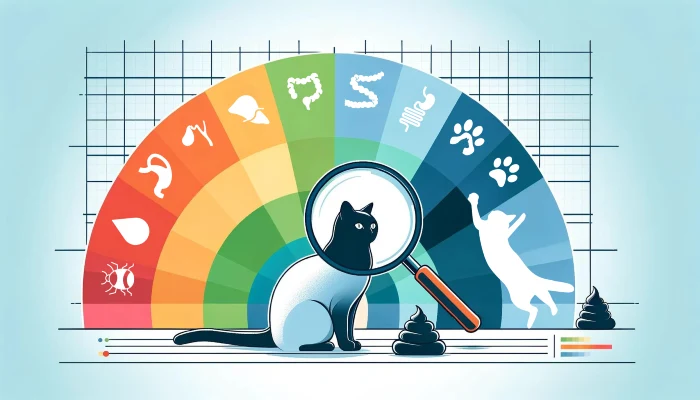The first time you catch your cat gasping for air, sprawled out on the floor after a seemingly mild play session, your heart might skip a beat. Is this normal post-play panting, or are we looking at a red flag waving frantically, signaling something much more sinister lurking beneath?
This isn’t about a simple case of the zoomies or a bad day; it’s about peeling back the layers to uncover the truth behind your cat’s heavy breathing. When your feline exhibits anything but their usual purr and prance, it’s a cue to lean in closer. Today, we’re dissecting the concerning phenomenon of cats breathing heavy, stripping away the mystery to equip you with knowledge and action steps.
Spotting the Warning Signs: Rapid Breathing and Respiratory Distress in Cats
Observing your feline friend for signs of respiratory distress is key. Symptoms like rapid breathing, open-mouth breathing, or any sort of panting can indicate underlying issues, such as heartworm disease or a serious case of respiratory infection. These are your flashing warning lights!
And if your cat’s heavy breathing comes with a side of reluctance to move or play, it’s time to pay attention.
Normal cat breathing should be almost invisible, a gentle rise and fall that’s as steady as a calm sea. But when you’re seeing their sides moving in and out with drama, or you can hear whistles and gasps punctuating each breath, the situation escalates from normal to concern-worthy. These are not just quirky new behaviors; they’re clinical signs shouting for attention.
Cats are masters of disguise, often hiding their discomfort until it’s impossible to ignore.
So, if your cat’s breathing seems more like a struggle than a simple in and out, consider it a call to action. Fast breathing, especially when your cat is at rest, is a glaring sign that not enough oxygen is making its way into their blood. And while a quick breath here and there could be brushed off as a momentary fluster, consistent fast breathing, or any type of panting in your kitty is a banner-raised high, signaling for a deeper investigation into their health.
Heart Disease, Fluid Build-Up, and Other Causes of Cat Breathing Difficulties
Heavy breathing in cats can stem from a variety of causes, including but not limited to heartworm disease, respiratory infections (viral and secondary bacterial infections), and heart disease, which can lead to an accumulation of fluid in the lungs or abdomen, causing difficulty breathing. In more serious cases, issues like pleural effusion or neurologic disorders might be at play, significantly impacting your cat’s ability to breathe normally.
Heartworm Disease
It’s a silent threat, often overlooked but deadly serious. Cats may not be the typical host for heartworms, but when infected, the consequences can be dire. Heavy breathing, along with coughing and lethargy, could signal heartworm’s presence. The solution? Prevention is key, and a monthly heartworm preventative medication can be a lifesaver.
Respiratory Infections
Whether viral or bacterial, these infections can turn your cat’s breathing from a silent whisper to a laborious chore. Secondary bacterial infections can escalate things, making every breath a battle. The remedy often involves antibiotics and supportive care, including steam to ease nasal breathing, and in some cases, oxygen therapy.
Heart Disease
Much like in humans, heart disease in cats can lead to an accumulation of fluid around the heart and lungs, making breathing a strenuous exercise. Heart disease is particularly common in fat or obese cats. Treatment might include medications to improve heart function and reduce fluid buildup, offering your cat relief from the effort of each breath.
Excess Fluid
Conditions like pleural effusion, where fluid accumulates in the chest cavity, can also be to blame for your cat’s heavy breathing. This excess fluid can compress the lungs, making it difficult for your cat to catch a breath. Treatment may involve draining the fluid to relieve pressure and help your cat breathe easier.
Neurologic Disorders and Other Causes
Sometimes, the issue might stem from neurologic disorders affecting the brain’s ability to regulate breathing or even tumors pressing against the respiratory tract. Each of these scenarios demands a tailored approach, from medication to manage symptoms to surgery for removing obstructions.
Recognizing the underlying cause of your cat’s heavy breathing is crucial for effective treatment. It’s a puzzle that requires professional insight for an accurate diagnosis, highlighting the importance of veterinary care in these situations.
CAT BREATHING HEAVY
When to Seek Immediate Veterinary Care for Breathing Problems
Prompt veterinary care is crucial when facing breathing difficulties. Conditions like respiratory infections and heartworm disease can quickly escalate, requiring emergency care or oxygen therapy.
Don’t hesitate to seek medical advice if you notice symptoms such as fast breathing, coughing, or an increased respiratory rate over a long period. Early detection and treatment can prevent more severe health concerns.
When your cat’s breathing changes, it’s more than just a worry; it’s a signal to act, and quickly!
Here’s how to know when a vet visit is non-negotiable:
- Dramatic Side Movement: If your cat’s sides are moving in and out heavily, it’s urgent.
- Unusual Noises: Whistling, gasping, or any odd sounds while breathing means trouble.
- Open-Mouth Breathing: Cats aren’t naturally open-mouth breathers. If they are, it’s a red flag.
- Other Distressing Symptoms: Watch for coughing, gagging, lethargy, or a blue tint to the gums. These signs, especially when combined with fast breathing, demand immediate action.
Don’t wait. If your cat shows any of these symptoms, especially rapid breathing at rest, get to a vet or an emergency animal hospital. Fast, effective action can make all the difference.
Treatment Options: Oxygen Therapy, Supportive Care, and Managing Heartworm Disease
Once at the vet, treatment will target the root cause:
- For Infections: Antibiotics might be needed.
- Heart Issues: Medications to improve heart function and reduce fluid can help.
- Respiratory Distress: Oxygen therapy might be necessary.
- Preventatives: Keeping up with heartworm preventatives is crucial for prevention.
Your vet might suggest blood tests, X-rays, or other diagnostics to pinpoint the problem. Following their advice is key to your cat’s recovery.
Guarding Their Health: Preventive Strategies and Home Care Tips for Cats with Breathing Issues
Preventive care, including monthly heartworm preventative medication, is essential. Keeping an eye out for early signs of respiratory problems and ensuring your cat avoids strenuous exercise that could exacerbate breathing difficulties are practical steps in safeguarding your cat’s health. Creating a stress-free environment at home can help manage conditions like heart disease and respiratory infections more effectively.
Prevention is always better than cure. Here are some steps to help:
- Monthly Heartworm Prevention: An absolute requirement to keep heartworms at bay.
- Watch for Early Signs: Catching symptoms early can prevent more serious issues.
- Create a Safe Space: Reduce stress and ensure your home is a calm environment for your cat.
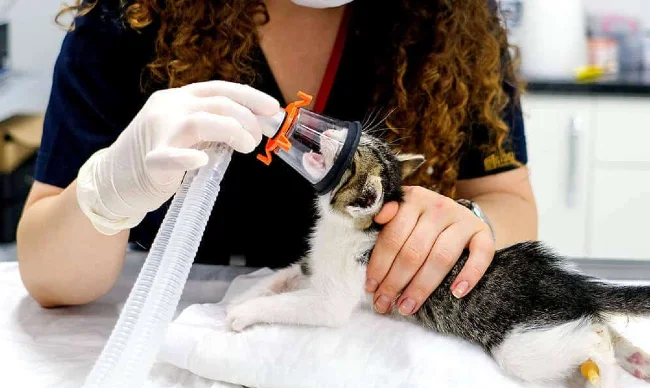
Veterinary intervention might include oxygen therapy for respiratory distress, medications to manage heartworm disease or bacterial infections, and supportive care to alleviate symptoms. In cases of excess fluid affecting the lungs or abdomen, procedures to remove the buildup of fluid may be necessary. Adhering to a regimen of monthly heartworm preventative medication can also play a key role in managing and preventing some conditions.
FAQ Section: Understanding Your Cat's Breathing Difficulties
Q: What causes rapid breathing or panting in cats?
A: Rapid breathing in cats can be caused by a range of issues, from stress and overheating to more serious conditions like heart disease, lung disease, and congestive heart failure. Foreign objects obstructing the nasal passages, viral infections, and fluid buildup in the lungs (pulmonary edema) or abdomen are also common causes.
Q: How can I tell if my cat’s breathing is abnormal?
A: Normal behavior for healthy cats includes a respiration rate of 20-30 breaths per minute. Signs of abnormal breathing include open-mouthed breathing, an increased number of breaths per minute, noticeable effort while breathing, and any change in the sound of their breathing. If you notice these signs, especially for a long period of time, it may indicate an underlying health issue.
Q: What should I do if I notice signs of respiratory distress in my cat?
A: If your cat is showing signs of respiratory distress, such as open-mouth breathing or an increased breathing rate, it’s crucial to seek urgent veterinary care. These symptoms could indicate a medical emergency, and early treatment is key to a better outcome.
Q: How will a vet diagnose my cat’s breathing issues?
A: For an accurate diagnosis of your pet, the vet will conduct a thorough examination, which may include listening to your cat’s lungs, checking for abdominal enlargement, and observing the breathing rate and effort. Diagnostic tests might include blood tests to check for heartworm or other infections, X-rays to look for a build-up of fluid or abnormalities in the lungs and heart, and possibly an ultrasound to examine the heart’s function and blood vessels more closely.
Q: What treatments are available for cats with breathing difficulties?
A: Veterinary treatment varies based on the underlying cause. It may include oxygen therapy to help with breathing, medications to treat heartworm disease or bacterial infections, diuretics to reduce fluid buildup, and, in some cases, surgery to remove foreign objects or drain fluid. Managing chronic conditions like asthma may involve long-term medication.
Q: How can I prevent respiratory issues in my cat?
A: Prevention includes keeping your home free of potential irritants that can cause nasal congestion or trigger asthma, ensuring your cat is up-to-date on vaccines to prevent viral infections, and administering monthly heartworm preventatives. Also, maintaining a healthy weight for your cat can reduce the risk of heart disease and respiratory problems.
Q: What are the most common symptoms of asthma in cats?
A: The most common symptoms of asthma in cats include wheezing, coughing, and difficulty breathing, often with an open mouth. Cats may also exhibit a hunched posture while trying to breathe. If you notice these common signs of asthma, consult your veterinarian for advice and potential treatment options.
Q: When is it time to take my cat to the veterinary hospital for breathing issues?
A: Immediate veterinary attention is warranted if your cat’s breathing issues are accompanied by signs of distress, such as persistent open-mouthed breathing, a rapid increase in breathing rate, blue-tinged gums, or if they’re unable to rest comfortably due to difficulty breathing. These could be symptoms of a more severe health concern, like congestive heart failure or severe cases of lung disease.
Q: Can emotional distress affect my cat’s breathing?
A: Yes, emotional distress can lead to rapid breathing or panting in cats. Stressful situations can trigger an increase in heart rate and respiration. Providing a calm environment and minimizing stressors can help maintain your cat’s respiratory and overall health.
Q: What long-term care considerations are there for a cat with chronic breathing problems?
A: Cats with chronic conditions like asthma or chronic bronchitis require ongoing care, which may include regular veterinary check-ups to monitor their condition, continued medication to manage symptoms, and adjustments to their living environment to reduce triggers. It’s also important for concerned pet parents to monitor their cat’s breathing rate and overall wellbeing closely, and to stay in touch with their veterinary hospital for ongoing support.
More To Discover
By understanding the potential causes of heavy breathing, recognizing the signs of respiratory distress, and knowing when to seek veterinary care, you can better manage your cat’s respiratory health and ensure they lead a comfortable and happy life.
In conclusion, understanding your cat’s breathing patterns and recognizing the signs of distress can save lives. When in doubt, always err on the side of caution and consult your vet. With the right care and attention, your cat can enjoy a healthy, happy life.








